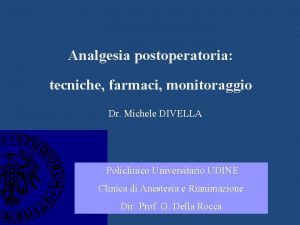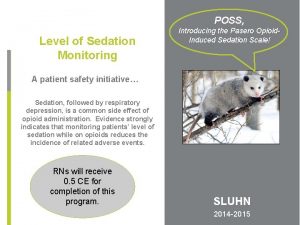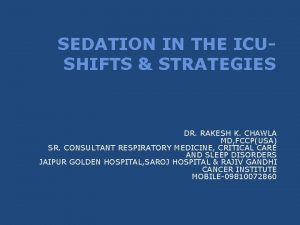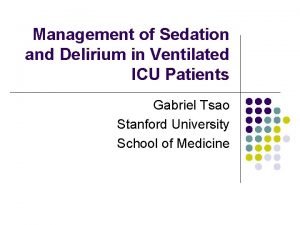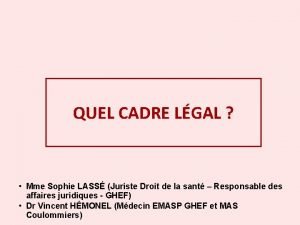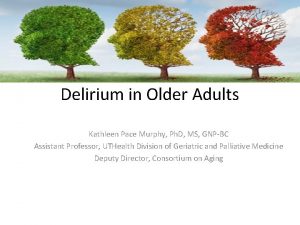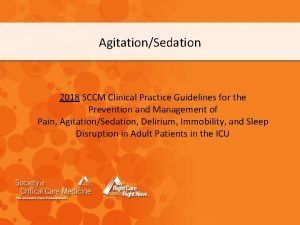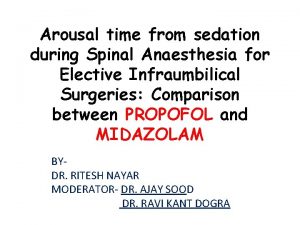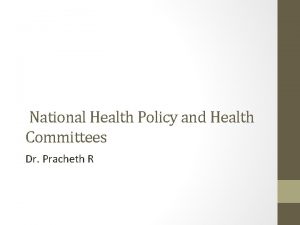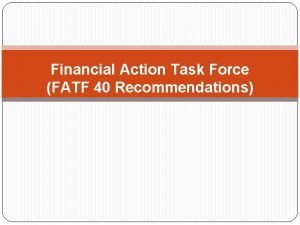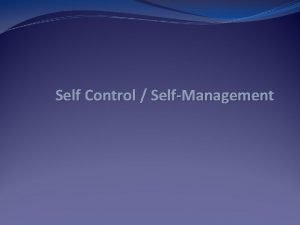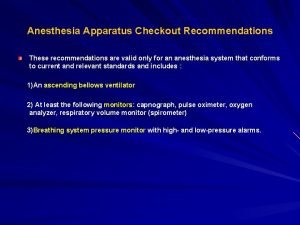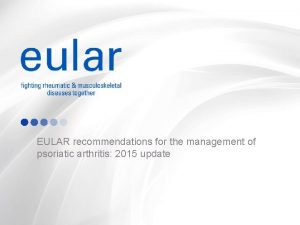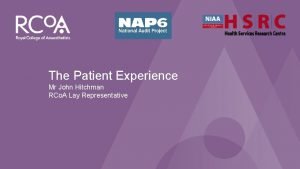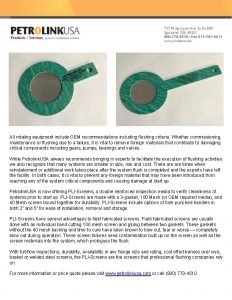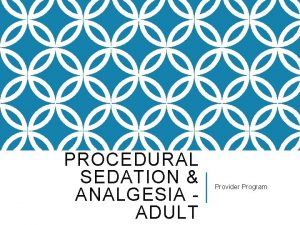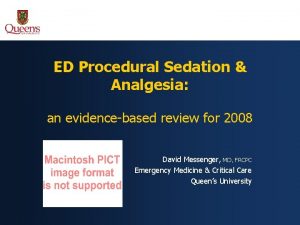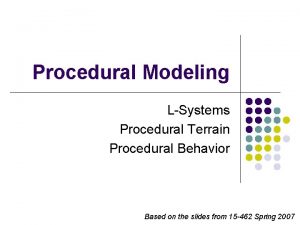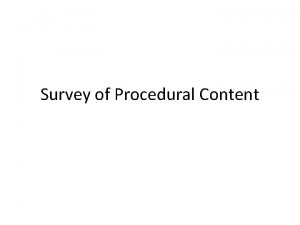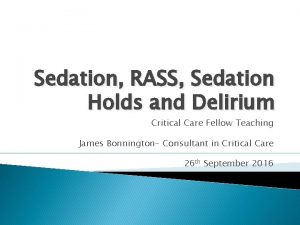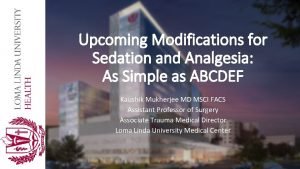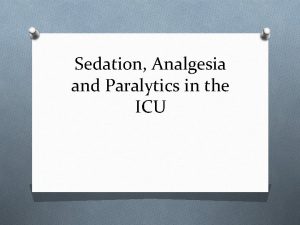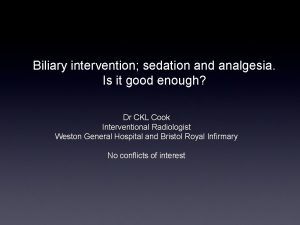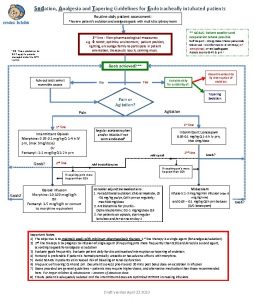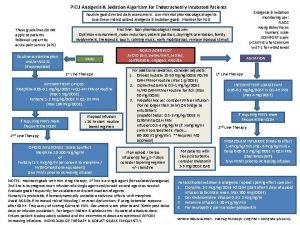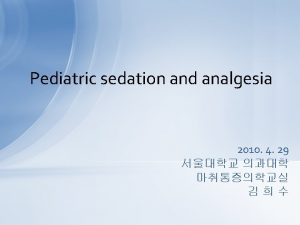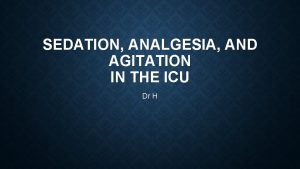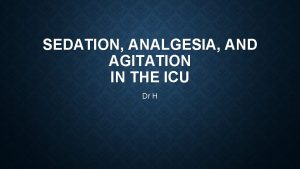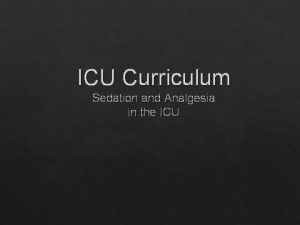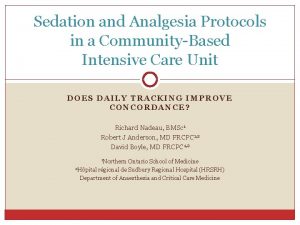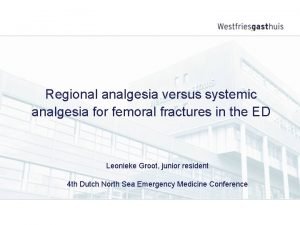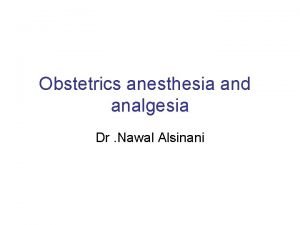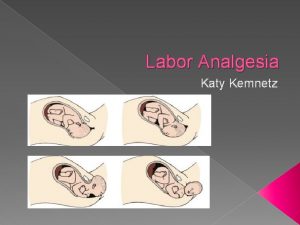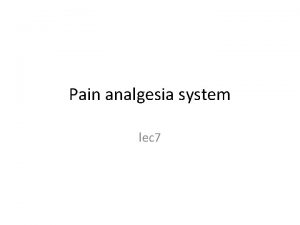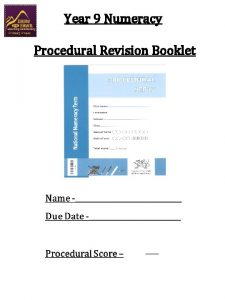PROCEDURAL SEDATION ANALGESIA REVISION OF 2005 RECOMMENDATIONS Daniel































- Slides: 31

PROCEDURAL SEDATION & ANALGESIA REVISION OF 2005 RECOMMENDATIONS Daniel Frick D. O. PGYII

Designation of Classes Class I- Highest quality data consisting of Randomized, controlled trial or meta-analysis of randomized trials Class II- non-randomized trial Class III- Case series, case report, review

Levels of Evidence to Recommendation Level A: Generally accepted with high degree of clinical certainty Level B: Strategy or range of strategies that reflect moderate clinical certainty Level C: Based on expert consensus in the absence of any adequate published literature

Definition of Procedural sedation and analgesia Procedural Sedation and analgesia � Technique of administering sedatives or dissociative agents w/wo analgesics to induce an altered state of consciousness allowing tolerance of painful or unpleasant procedures while preserving cardiorespiratory function Ann Emerg Med. 2014; 63: 247 -258

Levels of Sedation Minimal Sedation � Near baseline level of alertness during which patients respond normally to verbal commands � Cognitive function and coordination may be impaired � Ventilatory and cardiovascular functions unaffected Ann Emerg Med. 2014; 63: 247 -258

Levels of Sedation Moderate Sedation � Induce depressed level of consciousness during which patients respond purposefully to verbal commands alone or by light tactile stimulation � Airway is self-maintained with spontaneous ventilation. � Patient’s speech is often slurred and have delayed or altered responses to verbal stimuli � Moderate sedation will often induce event amnesia � Commonly achieved with a benzodiazepine, often Ann Emerg Med. 2014; 63: 247 -258 in conjunction with an opioid

Levels of Sedation Dissociative sedation � Trance-like cataleptic state characterized by profound analgesia and amnesia, with retention of protective airway reflexes with spontaneous respirations and cardiopulmonary stability � Ketamine is commonly administered to evoke dissociative levels of sedation � Used to facilitate moderate to severely painful procedures, as well as procedures requiring immobilization in uncooperative patients Ann Emerg Med. 2014; 63: 247 -258

Levels of Sedation Deep Sedation � pharmacologically induced depression of consciousness � Patients cannot be easily aroused but respond purposefully to repeated or painful stimulation � Ventilatory function may be impaired as well as spontaneous ventilation and protection of airway � Cardiovascular function is usually maintained � Propofol, etomidate, or a benzodiazepine Usually with opioid for painful procedures Also Ketofol Ann Emerg Med. 2014; 63: 247 -258

Levels of Sedation General anesthesia � Loss of consciousness � Unresponsiveness to all stimuli and the absence of airway protective reflexes, patients are not arousable, even by painful stimulation � Patients often require assistance in maintaining their airway and cardiovascular function may be impaired Ann Emerg Med. 2014; 63: 247 -258

Of Note……. Procedural Sedation does not apply to patients receiving analgesia for pain control without sedatives, sedation solely for the purpose of managing anxiolysis, behavioral emergencies, patient’s whom are intubated Ann Emerg Med. 2014; 63: 247 -258

Questions Covered 1. 2. 3. 4. Does pre-procedural fasting decrease risk of Emesis/aspiration? Does routine use of Capnography reduce incidence of adverse respiratory events? What is the minimum number of personnel necessary to manage complications? Can ketamine, propofol, etomidate, dexmedetomidine, alfentanil, and remifentanil be safely administered? Ann Emerg Med. 2014; 63: 247 -258

Does pre-procedural fasting decrease risk of Emesis/aspiration? Level B: Do not delay procedural sedation in adults or peds in the ED based on fasting time � Preprocedural fasting for any duration has not demonstrated reduction in risk of emesis or aspiration Systematic reviews and practice advisories acknowledge lack of evidence to support specific preprocedural fasting Four Class 2 trials with peds and one class 1 trial with adults and peds examined effect of fasting time (0 to >8 hrs) on emesis and aspiration during ED sedation � None demonstrated a significant difference in rates of emesis or aspiration when comparing fasting times Ann Emerg Med. 2014; 63: 247 -258

Robak et al. - Preprocedural fasting and adverse events in procedural sedation and analgesia in a pediatric emergency department: are they related? 1, 555 pediatric patients: ketamine, midazolam/fentanyl Findings � No relationship between fasting time and proportion of patients with adverse events Adverse No events Respiratory- apnea, laryngospasm, pulse ox <90% on room air Aspiration aspiration events documented! Ann Emerg Med. 2014; 63: 247 -258

Other Studies Treston- 257 pediatric patients undergoing procedural sedation with ketamine � Fasting did not correlate with the incidence of emesis-No clinically detectable aspiration and no airway maneuvers or suction required Mc. Kee et al- 471 peds patients with ketamine +/- oral analgesia Oral analgesia: 5% w/ emesis � Ketamine only: 2. 6% w/ emesis � Respiratory adverse events (~5%) similar between 2 groups � Bell et al- 400 adult and peds undergoing sedation w/ propofol No difference in adverse events between fasting and nonfasting Ann Emerg Med. 2014; 63: 247 -258 Emesis 0. 4% wo fasting, 0. 8% patients fasting �

Does the routine use of capnography reduce the incidence of adverse respiratory events? Level B: Capnography may be used as an adjunct to pulse oximetry and clinical assessment to detect hypoventilation and apnea earlier than pulse oximetry and/or clinical assessment alone in patients undergoing procedural sedation and analgesia in the ED Ann Emerg Med. 2014; 63: 247 -258

What is Capnography? Capnometry is the numeric display of exhaled carbon dioxide concentrations Allows continuous measurement of exhaled carbon dioxide and displays the resulting waveform graphically Provides an advantage over pulse oximetry alone by identifying respiratory depression more consistently Detects hypoventilation earlier than methods such as pulse oximetry and pulse rate alone, particularly when supplemental oxygen is Ann Emerg Med. 2014; 63: 247 -258 administered

The Facts! Waugh published a Class III meta-analysis including 5 studies � Capnography was 17. 6% times more likely to detect respiratory depression over standard monitoring alone- events like desat, requiring supplemental oxygen, requiring bag-valve mask Burton- ETCO 2 abnormalities demonstrated before pulse ox in 70% of patients having adverse event Miner et al- All episodes of respiratory depression detected by CO 2 monitoring where pulse ox only detected 33% Vargo et al- Study during endoscopy- 100% resp events detected by capnography, 50% by pulse ox, none by provider observation Ann Emerg Med. 2014; 63: 247 -258

The Facts! Deitch et al- Study of 80 pts with fentanyl and versed � 2011 study of 117 pts with fentanyl and versed � 35% of patients had respiratory depression with none of those episodes detected by provider 49% of patients had respiratory depression, but only detected in 25% of patient’s by pulse ox Anderson et al- Class III study with propofol sedation in peds during ortho procedures. � 100% of episodes of apnea and 60% of episodes of airway obstruction were detected by capnography before pulse ox Ann Emerg Med. 2014; 63: 247 -258

Does use of capnography provide clinically important benefit? �Multiple studies have shown decreased hypoxia with capnography Lightdale- Class II study during pediatric endoscopy reduction in hypoxia from 24% to 11% with capnography Qadeer Class II study in Adult endoscopy Reduction in hypoxia from 69% to 46% with capnography Deitch- Class II- Does capnography decrease incidence of hypoxic events in patients receiving propofol for procedural sedation? Ann Emerg Med. 2014; 63: 247 -258 absolute risk reduction 17% with capnography during

What is the minimum number of personnel necessary to manage complications? Level C recommendation: During Procedural sedation a nurse or other qualified individual should be present for continuous monitoring of the patient in addition to the provider performing the procedure A 2011 ACEP statement expressed strong support for qualified ED nurses to administer propofol, ketamine, and other sedatives under direct supervision of a privileged EM physician � Qualified meaning capable of detecting hypotension, hypoventilation, hypoxia, and dysrhythmias Ann Emerg Med. 2014; 63: 247 -258

The Facts! Few class III studies reporting from observational databse of ~1000 cases of Emergency-directed procedural sedations � Rate of complication defined as airway obstruction, apnea, hypotension, and hypoxia was similar (~4%) whether a single physician administered sedation and performed procedure or 2 physicians were present- 1 administering sedation and other performing the procedure. Nurse always present Another Class III study 457 sedations for orthopedic procedures No difference in incidence of adverse events requiring intervention between cases using 1 physician + 1 nurse vs. 2 physicians + 1 nurse � Adverse events: airway repositioning, suctioning, supplemental O 2, oral or nasal airway, BVM � Ann Emerg Med. 2014; 63: 247 -258

Can ketamine, propofol, etomidate, dexmedetomidine, alfentanil, and remifentanil be safely administered? Level A recommendation: � Ketamine can be safely administered to children for procedural sedation and analgesia in the ED. Propofol can be safely administered to children and adults in the ED Level B recommendation: � Etomidate can be safely administered to adults. A combination of propofol and ketamine can be safely administered to adults and children Level C recommendation: � Ketamine can be safely administered to Adults in the ED. Etomidate can be safely administered to children Ann Emerg Med. 2014; 63: 247 -258

Benefits of short-acting sedative agents Brief-acting sedative agents confer shorter periods of impaired levels of consciousness and therefore less risk for adverse respiratory events Shorter periods of patient’s impaired consciousness require shorter periods of monitoring and allocation of medical staff Ann Emerg Med. 2014; 63: 247 -258

Propofol >26, 000 patients and cases have been studied in regards to propofol as an agent for procedural sedation Dose: typically 1 mg/kg bolus followed by 0. 5 mg/kg every 3 -5 minutes Ketamine Ann Emerg Med. 2014; 63: 247 -258 Studies continue to support the use of Ketamine for children undergoing procedural sedation and analgesia Intravenous ketamine in adult population remains less common due to reported rates of emergence phenomena and recovery agitation Initial slow dose 1 mg/kg followed by 0. 5 mg/kg every

Treatable Ketamine side effects Nausea/emesis: Langston et al in double blind study showed significant reduction in vomiting in pediatric patients when given with Zofran � No adverse events were associated with use of zofran in this trial Hypersalivation: Brown et al. reported reduction in hypersalivation with use of atropine. � Hypersalivation with ketamine uncommonly has clinical implications during sedation Ann Emerg Med. 2014; 63: 247 -258

Ketofol Class I-III studies show: � Combination allows for decreased dosing of both agents compared to if either drug were used individually Typically use 0. 5 -0. 75 mg/kg of each agent Propofol associated hypotension and respiratory depression theoretically reduced with increased in circulatory norepinephrine induced by ketamine Ketamine associated nausea and emergence reactions theoretically reduced by antiemetic and anxiolytic properties of propofol Ann Emerg Med. 2014; 63: 247 -258

Ketofol 1 Class 1 study showed � Combination of ketamine and propofol, when compared to single agent sedations, resulted in higher provider satisfaction with sedation encounters Class I study � Shorter sedation times by approximately 19% or 3 minutes when combining the two agents Ann Emerg Med. 2014; 63: 247 -258

Etomidate Pro: � Etomidate has clinical characteristics similar to those of propofol including: onset of sedation, sedation depth, and duration of clinical effects Con: � Etomidate associated myoclonus Range from mild to severe in 20%-40% of patient’s Uncommonly result in clinically significant sequelae � Adrenal suppression has been demonstarted with cortisol depression for up to 24 hrs following only a single dose However levels remain within normal range with no clinically significant sequelae Ann Emerg Med. 2014; 63: 247 -258

What’s new? Alfentanil- ultrashort- acting analogue of fentanyl � Concluded to be safe when added to propofol for procedural sedation however noted an increase in patient’s who required stimulation to induce ventilation during procedural sedation � Study concluded no benefit derived from addition of Alfentanil to propofol with regards to rates of hypoventilation Dexmedetomidate � only one case report published addressing use of dexmedetomidate in procedural sedation Ann Emerg Med. 2014; 63: 247 -258

Conclusion Safe and effective sedation and analgesia in the ED is a critical skill that is core to the practice of Emergency Medicine! Successful sedation requires considerations of pitfalls and complexity of patient’s underlying physiology Always be ready for what might go wrong

 Elastomero morfina effetti collaterali
Elastomero morfina effetti collaterali Analgesia sistemica
Analgesia sistemica Evaluation of ncf 2005
Evaluation of ncf 2005 Revision passive voice
Revision passive voice Pasero opioid sedation scale
Pasero opioid sedation scale Rikers sedation scale
Rikers sedation scale Rass sedation scale
Rass sedation scale Sédation
Sédation Richmond agitation sedation scale
Richmond agitation sedation scale Sccm pad guidelines
Sccm pad guidelines Over-sedation
Over-sedation E-commerce in your inbox: product recommendations at scale
E-commerce in your inbox: product recommendations at scale Methods and metrics for cold-start recommendations
Methods and metrics for cold-start recommendations Npe 1986 12 parts
Npe 1986 12 parts Audit recommendations
Audit recommendations Personalized recommendations
Personalized recommendations Kartar singh committee
Kartar singh committee Fatf guidelines
Fatf guidelines Balwant rai committee
Balwant rai committee Recommendations of npe 1986
Recommendations of npe 1986 Kartar singh committee recommendations
Kartar singh committee recommendations Asking for advice situations
Asking for advice situations Jj irani committee
Jj irani committee Bootleg reinforcement
Bootleg reinforcement Qet meaning in ipcr
Qet meaning in ipcr Anesthesia delivery system testing
Anesthesia delivery system testing Eular psoriatic arthritis guidelines
Eular psoriatic arthritis guidelines Conclusion and recommendation example
Conclusion and recommendation example Nap 6 recommendations
Nap 6 recommendations Giving opinions en español
Giving opinions en español Oem recommendations
Oem recommendations Kothari commission report
Kothari commission report
